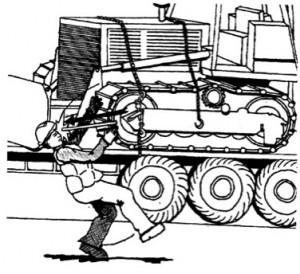BACKGROUND: A bulldozer operator was loading his dozer on a lowboy trailer and was binding it down to keep it from moving during transit. It was a typical late January day in the northern Lake States: mid-20s and light snow.
PERSONAL CHARACTERISTICS: The operator had many years’ experience operating equipment and his employer considered him to be a safe employee.
UNSAFE ACT OR CONDITION: After placing chains strategically across the bulldozer, the operator proceeded to attach load binders to the chains and secure them to the lowboy. To aid in getting the load binders shut and tight, he slid a pipe down the handle of the binder and, with this added leverage, used his weight and muscle power to close the binder. As he was tightening the binders, the pipe slipped off the end, striking the employee on the face, causing him to spin around and lose his footing, and pitching him headfirst onto the ground.
INJURY: The pipe struck him on the lip and cheek. The injury required nine stitches. He also received a black eye and missed a few days of work.
RECOMMENDATIONS FOR CORRECTION: Although the use of so-called “cheater pipes” is fairly common, it is generally not considered a safe practice. Since the pipe is not specifically designed to fit the binder handle, it often slips. Please consider the following options for tightening load binders and securing loads.
- The tension on the chains generally need not be greater than can be achieved without an extension device.
- If extra leverage is necessary, contact the manufacturer of your load binder. Often, the company has specifically engineered a binder extension device that safely provides increased leverage.
- Consider an alternative to chain or cable. Many log truckers now use synthetic web straps to secure their loads. The straps are strong, light, and durable, and a ratcheting device increases tension on the load.
- Some log truckers are switching to crib cages on their log trailers. Using some sort of cage to secure a load often eliminates the need for tie-down devices (check local state regulations).
 Courtesy of the Forest Resources Association: https://www.forestresources.org/
Courtesy of the Forest Resources Association: https://www.forestresources.org/
